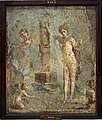File:Narcissus and echo.jpg
Narcissus_and_echo.jpg (382 × 450 pixels, file size: 41 KB, MIME type: image/jpeg)
| This is a file from the Wikimedia Commons. Information from its description page there is shown below. Commons is a freely licensed media file repository. You can help. |
Summary
| DescriptionNarcissus and echo.jpg |
English: In National Archaeological Museum, Naples |
| Date | |
| Source | Own work |
| Author | Rjdeadly |
Giulio Minervini, “Descrizione di un antico dipinto scoverto non lungi da Pompei, e che rappresenta il mito di Narcisso e di Eco,” Bullettino Archeologico Napoletano 40: no. 5 (1 February 1845): 33–34:
“In opening the section of the railway of Nocera a number of ancient buildings were encountered: and in truth it was a very natural thing, further confirmed by historical memory and previous examples that the whole littoral of our attractive crater was populated with pleasant villas whose remains were still partly preserved in the earth and that (the thing that makes us wonder) from time to time marble and bronze and other rare and valuable objects are found. In the following editions of our bulletin, we shall provide an indication of the precious objects of this nature that were discovered in the excavations for the railroad and are now in the Royal Bourbon Museum: for now we want bring to the attention of our readers a wonderful painting that was also found during those excavations that presents us with a subject that is new in archaeology, the myth of Echo associated with the more common subject, especially in Pompeii, of the sad death of Narcissus.
This beautiful painting was found in the excavations that were undertaken in the property of Sig. Scognamiglio at a site by the sea before the gate through which one enters Torre Annunziata. In that place was a partially discovered villa whose remains suggest great luxury. Large, highly decorated rooms were not lacking, done with the taste and style found in Pompeii, although they were to a large extent either fallen or collapsing. The beautiful rectangular painting of which we speak was detached from one of these walls and taken to the Royal Museum.
The unfortunate Narcissus is depicted standing next to a column, its funerary significance manifested by the ribbon that binds it and no less by the urn that sits on top of it. He is intent on admiring himself in the stream that runs at his feet. To his left, along the lower edge of the painting is a little stand supporting an overturned, three-handled jar. His pose, leaning heaviliy upon the column with his right hand seems to point to the fact that soon the goddesses will find his tomb there. On the other side of the stele, among the stones and protruding rocks can be seen the face and bust of a nude woman with bristling and unkempt hair and a sad expression on her face. Echo turns her glance, both desirous and furtive, towards Narcissus, all the while bending delicately as if to spy on him she is the act of pressing her lips to a tibia or a transverse flute. In the foreground beneath Echo, is a Cupid who raises his eyes sadly toward Narcissus as he kneels on his right knee. He is about to extinguish his torch in the same waters in which Narcissus is admiring himself. This tender composition, even though it has suffered the injuries of time, is worthy, it seems to me, of being included among the most beautiful and important wall paintings that have come down to us. If we are not deceiving ourselves, more than any other it resembles Greek vase painting. To illustrate this we proposed our observations to the Herculaneum Academy in the rather distant hope that our observations would be printed, accompanied by an illustration of the painting.”
Licensing
- You are free:
- to share – to copy, distribute and transmit the work
- to remix – to adapt the work
- Under the following conditions:
- attribution – You must give appropriate credit, provide a link to the license, and indicate if changes were made. You may do so in any reasonable manner, but not in any way that suggests the licensor endorses you or your use.
- share alike – If you remix, transform, or build upon the material, you must distribute your contributions under the same or compatible license as the original.
Captions
Items portrayed in this file
depicts
17 April 2020
image/jpeg
File history
Click on a date/time to view the file as it appeared at that time.
| Date/Time | Thumbnail | Dimensions | User | Comment | |
|---|---|---|---|---|---|
| current | 10:57, 17 April 2020 |  | 382 × 450 (41 KB) | Rjdeadly | Uploaded own work with UploadWizard |
File usage
Global file usage
The following other wikis use this file:
- Usage on fa.wikipedia.org
- Usage on gl.wikipedia.org
- Usage on mt.wikipedia.org
- Usage on ru.wikipedia.org

